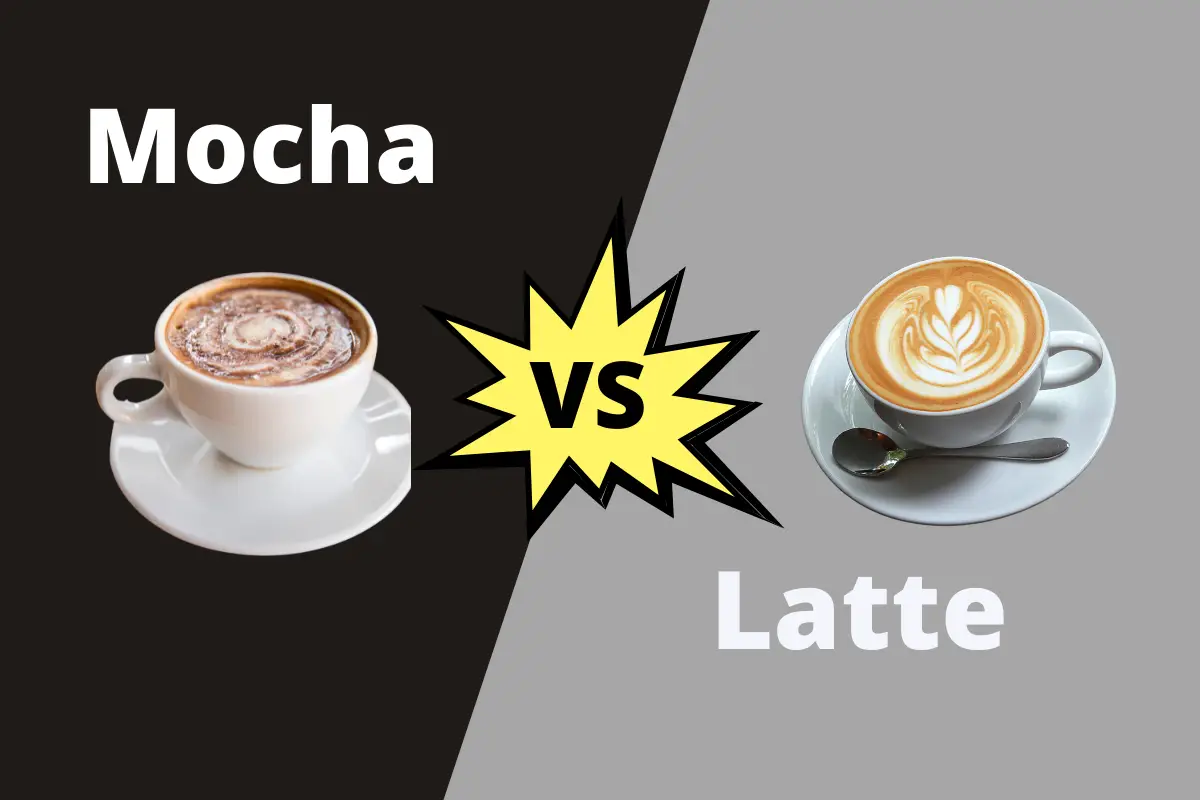The main difference between mocha and latte is that mochas are made with cocoa powder and chocolate syrup to give a chocolatey taste. Lattes are made of coffee and milk.
When you’re craving a coffee beverage, it can be hard to choose between the caffé mocha and caffé latte. Learn the differences between these two popular coffee drinks so that you can satisfy your craving.
Table of Contents
What is a Mocha?
Mocha coffee gets its name from Mokha — a city in Yemen. The mocha coffee beans used to prepare the popular brew are known to be the first species of wild coffee bean tended in the Middle Eastern country. Due to their natural chocolate flavor, mochas have a strong and rich flavor.
Though the mocha is chocolaty, baristas at coffee shops blend the arabica coffee beans with milk and dark or white chocolate syrup to add flavor. Starbucks uses mocha sauce and steamed milk topped with sweetened whipped cream to prepare a cup of mocha.

What Does a Mocha Taste Like?
People who like their coffee on the sweet side often compare mocha to hot chocolate. But, mochas are coffee-based, so they’re still different from hot chocolate. Mochas get their unique taste from the chocolate flavor complementing the double shot of espresso and hot milk.
Coffee shops may also add mint, hazelnut, or chocolate syrup to make the drink more satisfying. Replacing steamed milk and milk foam with whipped cream for your mocha is also a common practice to add variance to the taste.
How to Make a Mocha at Home
You don’t have to be a barista to reproduce the iconic Starbucks caffé mocha at home. You only need a Moka pot or an espresso machine to finish the job in under 3-5 minutes.
Get started with this espresso-based Mocha recipe:
Step 1: Use a Moka pot or an espresso machine to pull two espresso shots.
Step 2: Stir an equal proportion of chocolate into the espresso
Step 3: Add half a teaspoon of cocoa powder to the brewed coffee.
Step 4: Add 5 ounces of steamed milk on top of the mixture.
Step 5: Finish with whipped cream or frothed milk on top.
What is a Latte?
The caffe latte, a popular beverage among coffee enthusiasts in the United States, originated in Europe in the 18th century. Eventually, lattes became more popular among coffee houses in the 20th century.
The term latte comes from the Italian term caffe latte, meaning coffee and milk.
Unlike the mocha, the milky flavor is more dormant in a latte. This is because lattes consist of a 2:1 steamed milk-to-coffee ratio. In other words, use 2/3 cup steamed milk for every 1/3 cup of coffee. To prepare a latte, use milk foam, espresso, and steamed milk. Lattes are known for their attention-grabbing latte art created in the foam.

What Does a Latte Taste Like?
Though higher in caffeine than brewed coffee, the taste of a latte is derived from milk used in the coffee beverage, and the higher ratio of steamed milk contributes to the subtly sweet flavor a latte offers.
How to Make a Latte at Home
While most automatic espresso machines have a built-in latte recipe, you can make a latte with a steam wand or a milk frother.
Get started with this latte recipe:
Step 1: Pull a shot of espresso into the cup.
Step 2: Pour five to six ounces of steamed milk on the top.
Step 3: Use a milk frother to add air bubbles while breaking down fats in the milk and obtain microfoam.
Step 4: Top with frothed milk.
Baristas at local coffee shops often add beautiful latte art to give the beverage a finishing touch.
Mocha vs. Latte: A Detailed Breakdown
While both mochas and lattes use milk and espresso, most coffee lovers don’t know the differences between the two beverages.
Mocha vs. Latte: Similarities
Both coffee beverages use an equal ratio of coffee to milk and are prepared similarly. The drinks derive caffeine from espresso shots, making them almost similar to most coffee lovers.
Mocha vs. Latte: Differences
While both coffee beverages share certain similarities, lattes and mochas are two completely different beverages. Check out this comparison table below to explore the main differences.
Key Differences Between Mochas and Lattes
| Mocha | vs | Latte |
| Stronger chocolate flavor from cocoa powder or syrups, slight coffee flavor | Flavor | Smooth taste, mild coffee flavor |
| Mochas provide more energy, due to their caffeine content. | Health Benefits | Lattes are much healthier compared to mochas. |
| 2 Espresso Shots, steamed milk, chocolate | Ingredients | Espresso, frothed milk, garnished with milk foam on top |
| Dark, chocolate-brown color | Appearance | Light-brown |
| Smooth, due to the steamed milk | Consistency | Foamy, due to the frothed milk |
Comparing the Nutritional Values of Mochas and Lattes
| Mocha | vs | Latte |
| 16 fl oz | Nutritional value | 16 fl oz |
| 175 mg | Caffeine Content | 150 mg |
| 370 cal | Calories | 190 cal |
| 15g | Fat | 7g |
| 45 mg | Cholesterol | 30 mg |
| 150 mg | Sodium | 170 mg |
| 43 g | Carbohydrates | 19 mg |
| 14 g | Protein | 13 g |
Source: Starbucks
Mocha vs. Latte: Do you know the difference?
Mochas and lattes are almost equal in coffee strength, but they differ in caffeine content, ingredients used, taste uniqueness, and the nutritional value offered. If you have a sweet tooth, you should opt for a mocha, but if you prefer relishing an espresso, order a latte. And if you are looking for something that has the essence of both, ask the barista for a macchiato or a mochaccino.

